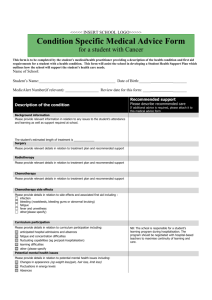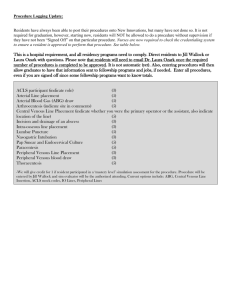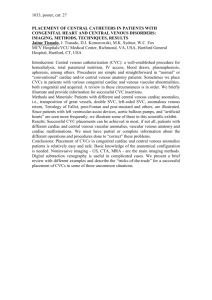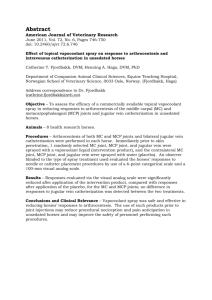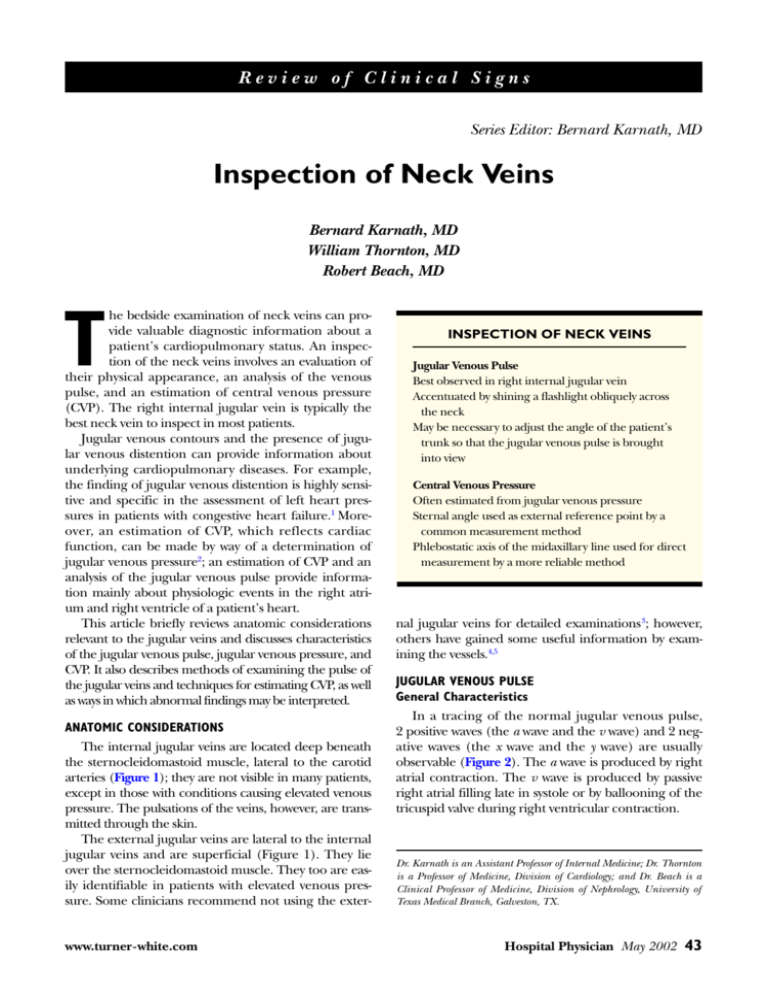
Review of Clinical Signs
Series Editor: Bernard Karnath, MD
Inspection of Neck Veins
Bernard Karnath, MD
William Thornton, MD
Robert Beach, MD
he bedside examination of neck veins can provide valuable diagnostic information about a
patient’s cardiopulmonary status. An inspection of the neck veins involves an evaluation of
their physical appearance, an analysis of the venous
pulse, and an estimation of central venous pressure
(CVP). The right internal jugular vein is typically the
best neck vein to inspect in most patients.
Jugular venous contours and the presence of jugular venous distention can provide information about
underlying cardiopulmonary diseases. For example,
the finding of jugular venous distention is highly sensitive and specific in the assessment of left heart pressures in patients with congestive heart failure.1 Moreover, an estimation of CVP, which reflects cardiac
function, can be made by way of a determination of
jugular venous pressure2; an estimation of CVP and an
analysis of the jugular venous pulse provide information mainly about physiologic events in the right atrium and right ventricle of a patient’s heart.
This article briefly reviews anatomic considerations
relevant to the jugular veins and discusses characteristics
of the jugular venous pulse, jugular venous pressure, and
CVP. It also describes methods of examining the pulse of
the jugular veins and techniques for estimating CVP, as well
as ways in which abnormal findings may be interpreted.
T
ANATOMIC CONSIDERATIONS
The internal jugular veins are located deep beneath
the sternocleidomastoid muscle, lateral to the carotid
arteries (Figure 1); they are not visible in many patients,
except in those with conditions causing elevated venous
pressure. The pulsations of the veins, however, are transmitted through the skin.
The external jugular veins are lateral to the internal
jugular veins and are superficial (Figure 1). They lie
over the sternocleidomastoid muscle. They too are easily identifiable in patients with elevated venous pressure. Some clinicians recommend not using the exter-
www.turner-white.com
INSPECTION OF NECK VEINS
Jugular Venous Pulse
Best observed in right internal jugular vein
Accentuated by shining a flashlight obliquely across
the neck
May be necessary to adjust the angle of the patient’s
trunk so that the jugular venous pulse is brought
into view
Central Venous Pressure
Often estimated from jugular venous pressure
Sternal angle used as external reference point by a
common measurement method
Phlebostatic axis of the midaxillary line used for direct
measurement by a more reliable method
nal jugular veins for detailed examinations3; however,
others have gained some useful information by examining the vessels.4,5
JUGULAR VENOUS PULSE
General Characteristics
In a tracing of the normal jugular venous pulse,
2 positive waves (the a wave and the v wave) and 2 negative waves (the x wave and the y wave) are usually
observable (Figure 2). The a wave is produced by right
atrial contraction. The v wave is produced by passive
right atrial filling late in systole or by ballooning of the
tricuspid valve during right ventricular contraction.
Dr. Karnath is an Assistant Professor of Internal Medicine; Dr. Thornton
is a Professor of Medicine, Division of Cardiology; and Dr. Beach is a
Clinical Professor of Medicine, Division of Nephrology, University of
Texas Medical Branch, Galveston, TX.
Hospital Physician May 2002
43
K a r n a t h , T h o r n t o n , & B e a c h : N e c k Ve i n s : p p . 4 3 – 4 7
Cartoid artery
Internal jugular vein
External jugular vein
Sternocleidomastoid
muscle
Wave forms
a
v
c
y
x
S1
S2
Heart sounds
Figure 2. Waveforms of the jugular venous pulse.
The descending limb of the x wave (the x descent)
and the descending limb of the y wave (the y descent)
represent drops in pressure in the right atrium and
right ventricle, respectively. The a wave is followed by
the x descent; however, the x descent is sometimes preceded by another positive wave—the c wave, which is
produced by tricuspid valve closure (Figure 2). The
v wave follows the ascending limb of the x wave and is
followed by the y descent.
Examination Techniques
Recommended steps in examining the jugular venous
pulse are provided in Table 1. The jugular venous pulse
is best observed in the right internal jugular vein with the
patient’s head turned away from the examiner. The jugular venous pulse can be accentuated by shining a flashlight obliquely across the neck. The angle of elevation of
the head of the bed must be large enough for the highest point of pulsation of the jugular vein to be easily iden-
44 Hospital Physician May 2002
Figure 1. Anatomic location of the internal and external jugular veins. The internal jugular veins are located beneath
the sternocleidomastoid muscle, lateral
to the carotid arteries. The external jugular veins lie over the sternocleidomastoid
muscle and are lateral to the internal
jugular veins. Redrawn by DM Russell
with permission from Ewy GA. Evaluation
of neck veins. Hosp Pract (Off Ed) 1987;
22:73.
tified (usually 30 to 45 degrees). The jugular venous
pulse is usually not visible when a patient sits in an
upright position. When it is visible in a patient sitting in
this position, it is a sign that venous pressure is elevated.
Occasionally, it may be difficult to differentiate
venous and carotid arterial pulsations in the neck. In
general, the venous pulse cannot be palpated because
of its low pressure. If a pulse can be felt, it is likely that
of the carotid artery. The jugular venous pulse waves
should be timed by simultaneous palpation of the
carotid arterial pulse; the a wave precedes the carotid
arterial pulse, whereas the v wave closely follows the
pulse. In general, the jugular venous pulse is seldom
observed in healthy young patients, but it is often
observed in elderly patients and in patients with diseases such as congestive heart failure.
Pulse Abnormalities
Large (or giant) a waves result from obstruction to
active right ventricular filling during right atrial contraction. They occur in conditions such as pulmonary
hypertension, pulmonic stenosis, and tricuspid stenosis
(Figure 3).6 Large a waves caused by right atrial contraction against a closed tricuspid valve or simultaneous
contraction of the right atrium and right ventricle are
termed cannon a waves; these waves occur in patients
with atrioventricular dissociation (with complete heart
block or ventricular tachycardia).6 The a wave is absent
in patients with atrial fibrillation. Large v waves result
from tricuspid regurgitation (Figure 3).6 An increased
x descent can be observed in conditions that cause
www.turner-white.com
K a r n a t h , T h o r n t o n , & B e a c h : N e c k Ve i n s : p p . 4 3 – 4 7
Table 1. Recommended Steps in Examining the Jugular
Venous Pulse
Adjust the angle of elevation of the head of the bed such that
the right internal jugular venous pulse is brought into view.*
The patient’s head should be turned away from the examiner. It may be necessary to shine a flashlight obliquely across
the neck.
Distinguish the jugular venous pulsations from the carotid
arterial pulsations. The jugular venous pulsations are not
palpable and vary with position.
Time the jugular venous pulse waves by simultaneous palpation of the carotid arterial pulse. The a wave precedes the
carotid arterial pulse, whereas the v wave closely follows
the pulse.
*The trunk of a patient is usually raised 30 to 45 degrees; however,
the trunk of a patient with elevated venous pressure may need to be
raised by as much as 90 degrees.
A
a
v
IVC
S2
S1
SVC
RV
RA
Systole
Diastole
C
B
v
a
a
v
S1
S2
S1
S2
large a waves and also constrictive pericarditis. An
increased y descent can be observed in conditions that
cause large v waves and also constrictive pericarditis.
JUGULAR AND CENTRAL VENOUS PRESSURE
General Characteristics
Jugular venous pressure reflects right ventricular filling pressure, and it remains the most reliable means of
estimating CVP.2 CVP is expressed in millimeters of
mercury (mm Hg) or centimeters of water (cm H2O).4
(Note: 1.36 cm H2O = 1.0 mm Hg.) In adults, normal
CVP is typically in the range of 5 to 9 cm H2O but can
be as low as 2 cm H2O.
Figure 3. Schematic representation of heart structures, blood
flow, and jugular venous pulse waveforms under normal (A)
and abnormal conditions (B and C). (B) A giant a wave caused
by tricuspid stenosis. (C) A large v wave caused by tricuspid
regurgitation. IVC = inferior vena cava; RA = right atrium,
RV = right ventricle; SVC = superior vena cava. (Illustration by
S. Jones and W. Thornton)
Examination Techniques
The right internal jugular vein should be used to
assess CVP because it is in direct line with the right atrium. The most common external reference point used to
determine CVP is the sternal angle (of Louis) (Figures 4A and 5).4 The right atrium is approximately 5 cm
below the sternal angle; this location allows the sternal
angle to be used as a reference point for measuring the
height of the blood column above the right atrium.
The CVP equals the vertical distance between an
imaginary line running parallel to the floor and extending from a point 5 cm below the sternal angle and an
imaginary line running parallel to the floor and extending from the highest point of pulsation of the jugular
vein (Figure 4A). Therefore, in a patient resting in a
supine position (usually at an angle of inclination of
30 to 45 degrees), a CVP measuring 9 cm H2O relates
to a jugular venous pressure extending 4 cm above the
sternal angle (Figure 4A). In general, only a CVP of at
least 7 cm H2O can be observed by this method because of visual obstruction by the clavicle.4
Another and more reliable method of determining
CVP, or even right atrial pressure, involves having the
patient rest in a supine position on a bed elevated so
that the highest point of pulsation of the right internal
jugular vein can be observed. (The angle of inclination
of the front of the bed is usually 30 to 45 degrees.) The
examiner begins by placing the zero mark of a centimeter ruler in the midaxillary line in the area of the fourth
intercostal space (Figure 6). The fourth intercostal space
is in the upper axilla. The space is found by the extent to
which the ruler can be moved forward in the midaxillary line (with the patient’s arm relaxed and resting at
his or her side) without displacement of normal tissue.
This point of the midaxillary line, the intersection of the
midanteroposterior level of the chest with the fourth
www.turner-white.com
Hospital Physician May 2002
45
K a r n a t h , T h o r n t o n , & B e a c h : N e c k Ve i n s : p p . 4 3 – 4 7
B
A
Highest point of
pulsation of the
jugular vein
4 cm
5 cm
9 cm
0 cm
CVP = 9 cm H2O
5 cm
5 cm
The sternal angle
10 cm
0 cm
CVP = 10 cm H2O
Figure 4. (A) Schematic representation of the measurement of central
venous pressure (CVP) through use
of the sternal angle in a patient resting
in a supine position. (B) If the jugular
venous pulse is visible in a patient sitting in an upright position, then the
central venous pressure is at least
10 cm H 2O and need not be measured. (Illustration by S. Jones and
W. Thornton)
Angle of elevation = 45 degrees
Figure 5. Measurement of central venous pressure through
use of the sternal angle.
Figure 6. Measurement of central venous pressure through
use of the midaxillary line.
intercostal space, is called the phlebostatic axis. This axis
is considered a true external reference point for the
right atrium.7 Placement of the zero mark of the ruler
in this location, in effect, places it at the level of the
mid–right atrium. The phlebostatic axis is considered
the anatomic “zero point” for a measurement of CVP.
That is, the height of the jugular venous pulse as measured vertically from this point can be considered a
direct measure of the CVP.
The centimeter ruler is held at a perpendicular
angle to the floor. The CVP, or right atrial pressure, is
the vertical distance between the zero mark of the
ruler (extending upward from the phlebostatic axis in
the midaxillary line) and an imaginary line running
parallel to the floor and extending from the highest
point of pulsation of the right internal jugular vein
(Figure 6). This method of measuring CVP, when compared with the method involving the sternal angle, is
more reliable owing to smaller degrees of variation in
measurements caused by the patient’s posture.8
In patients with elevated CVP, it may be necessary to
raise the patient’s trunk more than 45 degrees for the
pressure to be estimated. Clinicians, however, often
underestimate the CVP in these patients.4 Therefore, it
is recommended that clinicians simply determine
whether or not the CVP is elevated in all patients, without attempting to make a specific measurement.
As previously mentioned, the jugular venous pulse is
normally not observable in the neck of a patient sitting
in an upright position; a visible jugular venous pulse in
a patient sitting upright represents a CVP of at least
10 cm H2O (Figure 4B). Also, the CVP is abnormally
high in a patient when the vertical distance between
the highest point of pulsation of the internal or external jugular vein and the sternal angle is greater than
3 cm. Jugular venous pulsations may be visible to a
46 Hospital Physician May 2002
www.turner-white.com
K a r n a t h , T h o r n t o n , & B e a c h : N e c k Ve i n s : p p . 4 3 – 4 7
height of 25 cm above the sternal angle, resulting in
pulsations behind the angle of the jaw.
Elevated Venous Pressure
Elevated jugular venous pressure or CVP helps a
clinician identify disorders of mainly the right atrium
and right ventricle. However, elevated left-sided heart
pressures are transmitted through the pulmonary circulation and right ventricle.9 Thus, an analysis of jugular venous pressure and CVP can aid a clinician in
identifying disorders of the left side of the heart as well.
In general, elevated jugular venous pressure or CVP is
a poor prognostic indicator for patients with congestive
heart failure, indicating an increased risk for hospitalization and death.2
Clinical Signs Related to Jugular Venous Pressure
Kussmaul’s sign. During inspiration, mean jugular
venous pressure declines. However, in certain pathologic conditions the mean jugular venous pressure
increases during inspiration: this clinical finding is
known as Kussmaul’s sign.10 Kussmaul’s sign can be
explained by the inability of the heart to accommodate
increased venous return caused by negative intrapleural pressure. Kussmaul’s sign is seen in 33% of patients
with constrictive pericarditis.11 It can also be observed
in restrictive cardiomyopathy, right ventricular infarction, and acute cor pulmonale.
Abdominojugular reflux sign. In patients with a normal CVP at rest who are suspected of having right ventricular failure, elicitation of the abdominojugular reflux
sign may be useful. The sign is sometimes referred to as
the hepatojugular reflux sign, but this is a less appropriate name because it is not necessary to apply pressure to
the liver during elicitation. The sign is elicited by applying slow, steady abdominal pressure to the middle of the
abdomen for 15 seconds.5 A positive result on elicitation
is defined by an increase in jugular venous pressure of
more than 3 cm H2O that is sustained for longer than
15 seconds. The abdominojugular reflux sign is not specific to any particular disorder. Its sensitivity and specificity in predicting tricuspid stenosis, constrictive pericarditis, right ventricular infarction, or pulmonary
hypertension have not been studied.
CONCLUSION
The bedside examination of neck veins can provide
diagnostic information relating to underlying cardiopulmonary diseases, including information about CVP and
right ventricular hemodynamics. Despite the numerous
technological advances in diagnostic procedures for cardiopulmonary disorders, the bedside physical examination remains the most widely accepted means for initial
detection of these diseases. Furthermore, it is painless
and harmless to the patient.
HP
REFERENCES
1. Butman SM, Ewy GA, Standen JR, et al. Bedside cardiovascular examination in patients with severe chronic
heart failure: importance of rest or inducible jugular
venous distention. J Am Coll Cardiol 1993;22:968–74.
2. Economides E, Stevenson LW. The jugular veins: knowing enough to look. Am Heart J 1998;136:6–9.
3. Constant J. Using internal jugular pulsations as a manometer for right atrial pressure measurements. Cardiology
2000;93:26–30.
4. McGee SR. Physical examination of venous pressure: a
critical review. Am Heart J 1998;136:10–8.
5. Ewy GA. Evaluation of the neck veins. Hosp Pract (Off
Ed) 1987;22:72–5.
6. Cook DJ, Simel DL. The Rational Clinical Examination.
Does this patient have abnormal central venous pressure? JAMA 1996;275:630–4.
7. Potger KC, Elliott D. Reproducibility of central venous
pressures in supine and lateral positions: a pilot evaluation of the phlebostatic axis in critically ill patients.
Heart Lung 1994;23:285–99.
8. Haywood GA, Joy MD, Camm AJ. Influence of posture
and reference point on central venous pressure measurement. BMJ 1991;303:626–7.
9. Drazner MH, Rame JE, Stevenson LW, Dries DL. Prognostic importance of elevated jugular venous pressure
and a third heart sound in patients with heart failure. N
Engl J Med 2001;345:574–81.
10. Meyer TE, Sareli P, Marcus RH, et al. Mechanism underlying Kussmaul’s sign in chronic constrictive pericarditis.
Am J Cardiol 1989;64:1069–72.
11. Wiese J. The abdominojugular reflux sign. Am J Med
2000;109:59–61.
Copyright 2002 by Turner White Communications Inc., Wayne, PA. All rights reserved.
www.turner-white.com
Hospital Physician May 2002
47




